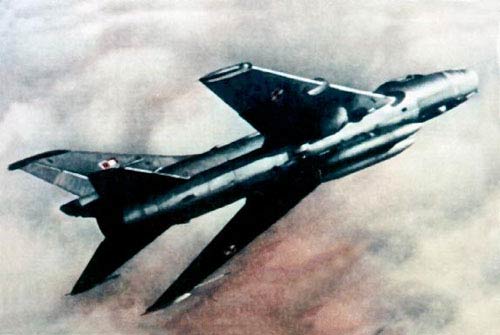Sukhoi Su-7 Fitter
Summary
| Category | Combat aircraft |
| Origin country | 🇨🇳 Ex-USSR |
| First flight | 7 September 1955 |
| Year of introduction | 1959 |
| Number produced | 1847 units |
| Average unit price | $3 million |
Description
Following Joseph Stalin's death, the Sukhoi OKB was re-established and initiated work on a swept-wing front-line fighter by the summer of that year. The first prototype, designated S-1, was designed to utilize the new Lyulka AL-7 turbojet engine and first flew on 7 September 1955. After the first eleven flights, the prototype was fitted with an afterburning version of the AL-7 engine. Testing was complicated by the unreliable engine, and only 132 were produced between 1957 and 1960. The aircraft entered service as Su-7 in 1959. The Su-7, originally conceived as a tactical, low-level dogfighter, was the first Soviet aircraft to use an all-moving tailplane and a translating centerbody, a movable inlet cone in the air intake for managing airflow to the engine at supersonic speeds. The aircraft featured a wing sweep of 60°, irreversible hydraulically boosted controls, and an ejection seat of Sukhoi’s own design. The initial prototype, known as the S-1, was designed to be equipped with three 37 mm Nudelman N-37 cannons and could carry 32 spin-stabilized 57 mm unguided rockets housed in a ventral tray.
The Su-7BKL's armament consists of two 30 mm Nudelman-Rikhter NR-30 autocannons, with 70 rounds per gun, for a total of 140 rounds. It features four under-wing and two under-fuselage hardpoints for a total of 2,000 kg (4,400 lb) of disposable stores. Two hardpoints are reserved for 2,300 L (510 imp gal; 610 US gal) drop tanks. The aircraft can carry combinations of UB-16-57U rocket pods for S-5 rockets, FAB-250 general-purpose bombs, FAB-500 GP bombs, or an 8U69 nuclear bomb.
The Su-7 saw combat in various theaters, initially with Egypt in the 1967 Six-Day War, the subsequent War of Attrition, and later in the Yom Kippur War, where it was used to strike Israeli ground forces. The Indian Air Force also employed the Su-7 extensively during the 1971 war with Pakistan, with six squadrons flying nearly 1,500 offensive sorties and undertaking the bulk of daytime attack missions, maintaining a high operational tempo. While the IAF suffered some losses, it was found that the Su-7 had high survivability, often returning to base despite heavy damage. Operational weaknesses of the Su-7 included its short combat radius and need for long runways, limiting its overall usefulness; however, it was widely exported, and operated by the air forces of Afghanistan, Algeria, Czechoslovakia, Egypt, India, Iraq, North Korea, Poland, Syria and the Soviet Union.
Main Variants:
-
Su-7A: The initial production model, designed as a frontline fighter, it saw limited operational use in the Far East and was soon retired as priority shifted to the MiG-21.
-
Su-7B: The first ground-attack variant, it incorporated structural refinements for low-altitude, high-speed operations, eventually becoming the main Soviet ground-attack aircraft of the 1960s.
-
Su-7BM: This variant featured an upgraded AL-7F-1 engine, an enhanced fuel system with external piping, wing-mounted fuel tanks, "wet" underwing hardpoints, and the capability to carry tactical nuclear bombs.
-
Su-7BKL: A rough field-capable version, it was equipped with skids on the main landing gear, provisions for JATO rockets, and twin brake parachutes to improve takeoff and landing performance.
-
Su-7BMK: This was a simplified export version of the Su-7BM, designed for foreign operators with slightly reduced capabilities.
Technical specifications
| Version: Su-7BKL Fitter-A | |
|---|---|
| Crew | 1 pilot |
| Maximum speed | 2150 km/h (1336 mph) |
| Wing area | 34 m² (366.0 sqft) |
| Wingspan | 9.3 m (30.5 ft) |
| Height | 5.0 m (16.4 ft) |
| Length | 16.6 m (54.5 ft) |
| Service ceiling | 17600 m (57743 ft) |
| Empty weight | 8937 kg (19703 lbs) |
| Max. takeoff weight | 15210 kg (33532 lbs) |
| Climb rate | 160.0 m/s (524.9 ft/s) |
| Takeoff distance | 950 m (3117 ft) |
| Powerplant | 1 × turbojet AL-7F-250 delivering 6800 kgp, up to 9600 kgp with afterburner |
| Ejection seat | Severin KS-4 |
Current operating countries
| Country | Units | ||
|---|---|---|---|
|
|
North Korea | 18 | |
Numbers in parentheses, e.g. '(+5)', indicate units ordered but not yet delivered.
All operators
Afghanistan • Algeria • Egypt • India • Iraq • Poland • North Korea • Russia • Syria • Ex-Czechoslovakia • Turkmenistan • Ex-USSR • United States • Vietnam • Yemen
Armament
Bombs payload:
- Low-Drag FAB-100
- Low-Drag FAB-250
- Low-Drag JSC NPO Basalt FAB-500
Photo of Su-7 Fitter

3-view profile
